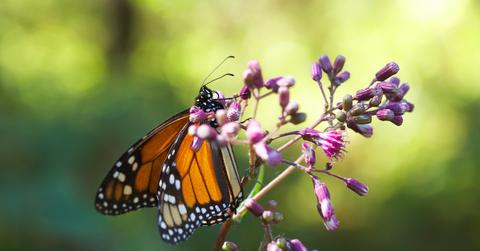Monarch Butterflies Are Migrating Right Now — but They’re Few and Far Between
Published Sept. 22 2021, 1:40 p.m. ET

It's finally the first day of fall, and if you're as enamored with foliage as we are, you're probably in the midst of breaking out your comfy sweaters, soup recipes, and beanies. And right now, monarch butterflies are kind of doing the same thing, in terms of getting back into their autumnal routines. The monarch migration radar, which shows the monarch butterfly's winter route, is seriously fascinating — but sadly, it shows just how endangered monarchs are.
"Migration is not an uncommon phenomenon," the California Department of Parks and Recreation explains, as per Travel + Leisure. "In October, as colder weather approaches, the butterflies instinctively know they must fly south to escape the freezing temperatures. Some have to fly over 1,000 miles. The journey is hazardous and many never make it. By November, most are sheltering in trees stretching from the San Francisco Bay Area south to San Diego."

What is the monarch migration radar showing?
Butterflies migrate south using their inner circadian clocks and the positioning of the sun, according to Phys, to find warmth for the winter. Monarch butterflies are currently in the midst of migrating to the central and southern California coasts (if they're from west of the Rocky Mountains) and Mexico (if they're coming from the East Coast), according to Travel + Leisure. Earlier this month, hoards of them were spotted flying and creating roosts throughout Illinois and Wisconsin.
Over the last week, according to Journey North, monarchs from the eastern U.S. have been spotted throughout southern Canada, the upper Midwest, and even as far down as a few southern U.S. states. Much of the western monarch population, on the other hand, has been seen migrating down from the Northwest, feeding on milkweed and other flowers in bloom. Supposedly it looks as though there are more monarchs that last year, but we won't know until reports are complete from 2021.
"Monarch migration captured on radar!" CBS21 News meteorologist, Ed Russo, tweeted on Wednesday, Sept. 22.
"A boundary moved through Oklahoma City Monday creating a wind shift to the north. You can see them on reflectivity behind the boundary. Butterflies ride the north wind so they don’t have to flap as much heading south to Mexico," he continued, attaching footage of the migration to the tweet. Check it out, below.
Are monarch butterflies endangered?
Sadly, the monarch butterfly is extremely threatened due to use of pesticides in the agriculture industry, deforestation, land development, and global warming — though they aren't federally protected. The government refrains from adding them to the protected species list, as to care for other "more important" endangered species at a higher priority. The monarch population has plummeted by upwards of 80 percent since the '90s, and monarch sightings have become increasingly rarer.
According to Lompoc Record, it generally isn't uncommon to see roosts of monarchs at California's Pismo State Beach during this time of year — but the numbers have rapidly deteriorated over the years.
“It’s too depressing to even think about,” local Jan Ojerholm told Lompoc Record. “In 1990, we had a high count of 230,000 butterflies in the grove... This year in the Thanksgiving Day count, we had 188, although one person came up with 300, but that wasn’t the official number."
You can help repopulate the monarch by planting local native plants, including nectar sources and milkweed, and refraining from using pesticides — it's up to us to save these gorgeous creatures from extinction.